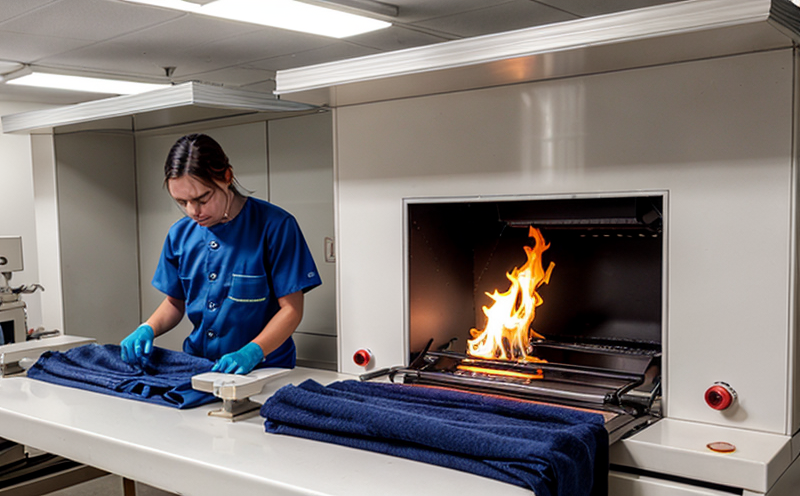Fire Resistance Testing of Fire Blankets and Textile Sheets
In today’s world, fire safety is a critical concern in various sectors including manufacturing, construction, and healthcare. The need for robust, reliable fire protection materials has never been greater. One such material that plays an indispensable role in fire safety is the fire blanket and textile sheets. These materials are designed to withstand high temperatures and provide a barrier against flames. This service page focuses on our expertise in fire resistance testing of fire blankets and textile sheets, ensuring they meet stringent international standards for quality, performance, and reliability.
The fire resistance test evaluates the ability of fire blankets and textile sheets to resist ignition and spread of flame when exposed to high temperatures. This comprehensive evaluation ensures that these materials are safe and effective in real-world scenarios. The test involves placing a specimen of the material under controlled conditions where it is subjected to heat, flame, or both for a specified duration.
The international standard most commonly used for fire resistance testing is ISO 11697-2:2020, which specifies the methods for determining the flame spread and thermal insulation properties of textile materials. This standard ensures that all participants in the industry use consistent methods to measure the performance of fire blankets and textile sheets.
During the testing process, the specimen is exposed to a specified heat source for a period defined by the ISO 11697-2:2020. The material’s performance is then assessed based on its resistance to ignition and the extent of flame spread. The results are reported in terms of the time it takes for the material to ignite, the duration of the fire, and the level of heat transfer.
Quality managers and compliance officers rely heavily on these tests to ensure that the materials they use meet regulatory requirements. R&D engineers benefit from this testing as they can refine their designs based on the performance data obtained. Procurement teams also find value in this service as it helps them source reliable suppliers who adhere to strict quality standards.
The fire resistance test is a cornerstone of fire safety protocols, providing assurance that materials used in critical environments are up to the task. By adhering to international standards like ISO 11697-2:2020, we ensure that our testing is both accurate and reliable.
Our laboratories employ state-of-the-art equipment to conduct these tests under controlled conditions. This ensures that the results are consistent and repeatable. We also use highly trained technicians who have extensive experience in conducting fire resistance tests. The combination of advanced technology and skilled personnel guarantees that our testing is both precise and thorough.
The importance of this test cannot be overstated, especially given the high stakes involved in fire safety. Our service ensures that materials used in critical environments are safe and effective, thereby protecting lives and property.
Scope and Methodology
The scope of our fire resistance testing service includes a detailed evaluation of the fire blankets and textile sheets according to international standards. The methodology involves several key steps:
- Preparation of Specimen: The specimen is cut to standard dimensions as specified in ISO 11697-2:2020.
- Heating and Exposure: The specimen is exposed to a controlled heat source for the duration stipulated by the standard.
- Evaluation of Performance: The performance is assessed based on ignition resistance, flame spread, and thermal insulation properties.
- Data Collection: Detailed data is collected throughout the testing process to ensure comprehensive reporting.
Why Choose This Test
Selecting fire resistance testing for your fire blankets and textile sheets is essential for several reasons. First, it ensures that these materials meet stringent international standards, providing a level of assurance that they will perform as expected in real-world scenarios.
Secondly, the test results can be used to refine designs and improve product performance. This continuous improvement cycle helps manufacturers stay ahead of regulatory changes and market demands.
For quality managers and compliance officers, this service offers peace of mind that they are meeting all relevant safety regulations. It also provides a benchmark against which future products can be compared, ensuring consistent quality across the product line.
R&D engineers benefit from detailed performance data that informs their design decisions. This information is crucial for innovation and development in fire protection materials.
Lastly, procurement teams gain access to reliable suppliers who adhere to strict quality standards. By choosing suppliers based on their compliance with the test results, they can ensure the integrity of the supply chain.
Environmental and Sustainability Contributions
- Emissions Reduction: By ensuring that fire blankets and textile sheets are flame retardant and resistant to high temperatures, these materials contribute to reducing emissions from fires.
- Sustainable Materials: Using sustainable materials in the production of fire-resistant textiles helps minimize environmental impact. This aligns with broader sustainability goals within industries.
- Reduced Waste: Reliable fire resistance testing ensures that only high-quality materials reach market, thereby reducing waste associated with substandard products.





